Research on Optimal Scheduling of Multi-Energy Microgrid Based on Stackelberg Game
Abstract
:1. Introduction
- A low-carbon economic optimization model of microgrid with tiered carbon price was constructed. The carbon emissions involved in the operation of each equipment are finally traded through the carbon trading market, and the sensitivity analysis of the system is carried out by adjusting the ladder carbon trading parameters.
- A Stackelberg game model with microgrid as the main body of the game and user response as the follower of the game was established, which further improved the level of load participation in the energy system and proved the existence of equilibrium solutions in the game. The model is iteratively solved by a variety of group algorithms, and immigration operators and artificial selection operators are added to the traditional genetic algorithm to prevent all individuals in the population from tending to the same state and stop evolution, and at the same time increase the memory population and improve the model calculation efficiency.
2. Optimization Model of Micro-Grid Low-Carbon Economy with Ladder Carbon Price
2.1. Stepped Carbon Trading Model
2.1.1. Calculation Model of Carbon Emissions
2.1.2. Carbon Decentralization Quota Model
2.1.3. Stepped Carbon Trading Model
2.2. Microgrid Low-Carbon Economic Optimization Model with Step Carbon Price
2.2.1. Objective Function
- Fuel cost
- b.
- Energy purchase cost
2.2.2. System Operation Constraints
- Electric power balance
- b.
- Thermal power balance
- c.
- Natural gas power balance
- d.
- Hydrogen power balance
- Coal-fired units
- b.
- Cogeneration unit
- c.
- Electro-gas conversion technology
- d.
- Gas-fired boiler unit
- e.
- Hydrogen fuel cell
3. Game Theory Basis
3.1. Participants
3.2. Strategy Set
3.3. Effectiveness
3.4. Stackelberg Game
- (1)
- There is no agreement among the participants, and they make their own decisions.
- (2)
- The decision of each participant has an impact on the benefits of other participants.
- (3)
- Because of the different market positions, there is a decision-making order among the participants. The leader first makes appropriate decisions according to the target benefit, and the followers make decisions on their own goals after receiving the leader’s decision-making signal. There is a restrictive relationship between them.
- (4)
- The final decision-making scheme of each participant needs the unanimous consent of all participants.
4. Multi-Energy Microgrid Model Based on Stackelberg Game
4.1. The Demand Response Type
4.2. Microgrid-User Stackelberg Game Structure
4.3. Microgrid Revenue Model
4.3.1. Objective Function
4.3.2. Constraints
4.4. User Benefit Model
4.4.1. Objective Function
4.4.2. Constraints
- Satisfaction with electricity consumption mode
- b.
- Expenditure satisfaction
4.5. Establishment and Proof of Microgrid-Client Stackelberg Game
- Game participants: participants in the game of microgrid and users as the main slave, expressed in the form of set as follows .
- Strategy set: The microgrid is the leader in the Stackelberg game and the optimization strategy is Formulated first, and the electricity price strategy proposed by the microgrid to the user is represented by the set . The set of load adjustment strategies made by the user is represented by set .
- Utility: The cost set of the microgrid is represented by set , and the benefit set of users is represented by . the cost collection of microgrid.
- The decision schemes of leaders and followers are all non-empty bounded convex sets;
- After the top leaders make decisions, the followers have corresponding unique solutions;
- After the lower followers respond, the leader has a unique solution.
- As shown in Formulas (46) and (50), the policy set and are non-null bounded convex set;
- As shown in Formulas (52)–(54), each term in is a linear or constant function with respect to or , then is a concave function with respect to and .
- As shown in Formulas (51) and (52), is a continuous function with respect to and .
5. The Solution Method of Game Model Based on Multi-Population Genetic Algorithm
- (1)
- Initializing the operation parameters of the microgrid and the load data of the user terminal, and sending the electricity price strategy drawn up by the microgrid to the lower layer;
- (2)
- Converting the maximum energy consumption benefit of the user terminal into a negative cost, feeding back according to the pricing signal of the microgrid, and feeding back the load signal to the upper-level dispatching;
- (3)
- The microgrid solves the objective function through the feedback signal;
- (4)
- Judging whether the game equilibrium solution is reached, and if so, outputting the result; otherwise, return to (2) to continue scheduling.
6. Example Analysis
6.1. Basic Data
6.2. Game Equilibrium Results
6.3. Optimization of Operation Results
7. Conclusions
- (1)
- Comparative analysis without considering demand response scenarios shows that the optimization cost of microgrid operation considering price-based demand response scenarios has decreased by 5%, which is 668.95 yuan. Among them, the power purchase cost has decreased by 23.8%, which is 778.6 yuan, the carbon emissions have increased by 17%, which is 83.96 kg, and the carbon trading cost has increased by 1.8%, which is 41.98 yuan. This proves that the introduction of demand response can improve the overall economic benefits of microgrids while slightly increasing environmental costs.
- (2)
- After considering demand response, the selling price of microgrids is always lower than the purchase price from the distribution network, and the price reduction rate is relatively high during the initial load valley, encouraging users to adjust their load during the time period. After the demand response, the user’s load curve underwent significant adjustments and transformations, and the corresponding load transfer was carried out according to the price signal of the microgrid, achieving the expected “peak shaving and valley filling” effect of microgrid scheduling.
- (3)
- In the microgrid scheduling scenario considering price-based demand response, the electricity purchase period is mainly distributed during the low and flat peak periods of tiered electricity prices. Due to the transfer of user load, the energy pressure caused by user load is reduced.
Author Contributions
Funding
Data Availability Statement
Conflicts of Interest
Glossary
| Symbol | Meaning |
| Gas purchases | |
| Purchase electricity | |
| Power-hungry devices | |
| Air consumption equipment | |
| The amount of emitted by coal-fired power plants | |
| The amount of captured by the carbon capture equipment | |
| Unit electrical power | |
| Carbon allowances per unit of power consumed by different devices | |
| Carbon trading costs | |
| Net carbon emissions of the system | |
| Equipment options, including cogeneration units, gas-fired boilers, and coal-fired power plants | |
| Total number of devices | |
| Price growth rate | |
| The length of the interval | |
| Carbon trading base price | |
| Minimum operating costs of the system | |
| Fuel costs | |
| Electricity purchase costs | |
| The cost of purchasing gas | |
| Overall system air consumption | |
| Real-time electricity prices | |
| Real-time gas prices | |
| Take 24 h | |
| Wind energy output power | |
| The power output of the cogeneration unit | |
| Discharge power of power storage equipment | |
| Hydrogen fuel cells produce electricity | |
| Electrical load | |
| The amount of charge of the storage device | |
| Combined heat and power unit thermal energy output power | |
| Gas boiler heat generation | |
| Heat release from heat storage equipment | |
| Heat storage equipment stores heat | |
| Heat load | |
| Gas purchases | |
| Air receiver outgassing | |
| The amount of produced by methanation in power-to-gas technology | |
| Gas load | |
| Gas storage capacity for gas storage equipment | |
| Air consumption of a cogeneration unit | |
| Gas boiler units consume natural gas | |
| The amount of hydrogen produced by the electrolyzer in the first step of electro-to-gas | |
| Hydrogen storage equipment storage capacity | |
| Hydrogen consumption in methanation reactions | |
| Hydrogen fuel cell hydrogen consumption | |
| The amount of hydrogen released by hydrogen storage equipment | |
| Upper limit of coal-fired unit output | |
| Lower limit of coal-fired unit output | |
| The maximum uphill climbing power of coal-fired units | |
| Maximum downhill climb power of coal-fired units | |
| The amount of power change | |
| time coal-fired unit power | |
| time coal-fired unit power | |
| Upper limit of electrical output of cogeneration units | |
| Lower limit of electrical output of cogeneration units | |
| Lower limit of thermal output of cogeneration units | |
| Upper limit of thermal output of cogeneration units | |
| The maximum upward climb power of the cogeneration unit | |
| Maximum downhill climb power of cogeneration units | |
| Maximum downhill climb power of cogeneration units | |
| The electrical power of the cogeneration unit after conversion at time | |
| The electrical power of the cogeneration unit after conversion at time | |
| The upper limit of hydrogen production capacity of the electrolyzer | |
| The lower limit of hydrogen production by the electrolyzer | |
| The upper limit of the amount of resulting from the reaction | |
| Lower limit of the amount of resulting from the reaction | |
| The maximum uphill climb power of the electrolyzer | |
| The maximum uphill climb power of the methanation reaction | |
| Maximum downhill climb power of the electrolyzer | |
| Methanation reaction maximum downhill climb power | |
| The amount of power change in the electrolyzer | |
| The amount of change in methanation reaction power | |
| Electrolyzer power at time | |
| Methanation reaction power at time | |
| Upper limit of gas boiler output | |
| Lower limit of gas boiler output | |
| The maximum upward climbing power of the gas boiler | |
| Maximum downhill climb power of gas boilers | |
| The amount of change in power | |
| Gas boiler power at time t | |
| time gas boiler power | |
| Upper limit of hydrogen fuel cell output | |
| Hydrogen fuel cell minimum uphill climb power | |
| The amount of change in power | |
| The power of the gas boiler at the time | |
| The power of the gas boiler at the time | |
| The cost of purchasing electricity to the upper grid in the game model | |
| The electricity price revenue sold by the microgrid to the user | |
| The cost of purchasing gas | |
| Carbon trading costs in game models | |
| The unit price of electricity sold in the distribution network | |
| Electricity purchased by the microgrid | |
| The electricity purchased by the user is sold by the microgrid | |
| The amount of power after the user responds | |
| The lower limit of the amount of electricity that the microgrid purchases from the distribution grid | |
| The upper limit of the amount of electricity that microgrids can purchase from the distribution grid | |
| The upper limit of the electricity price that microgrid can sell to users | |
| The lower limit of the electricity price sold by the microgrid to the user | |
| The output power of the electrical energy of the cogeneration unit | |
| The discharge power of the power storage device | |
| The power generation of hydrogen fuel cells | |
| The power to charge the storage device | |
| Changes in user electricity consumption before and after demand response | |
| The user’s electricity consumption before the demand responds | |
| The upper limit of the demand response preload value | |
| The lower bound of the demand response preload value | |
| The upper limit of the demand response afterload value | |
| The lower bound of the demand response afterload value | |
| User’s interests | |
| User energy preference coefficient | |
| The lower limit of user satisfaction with electricity consumption | |
| Electricity consumption by users before demand response | |
| Minimum consumer spend satisfaction | |
| Optimal operation scheme of microgrid | |
| Optimal response on the user side | |
| Other strategies except | |
| Other strategies except |
References
- BP World Energy Statistical Yearbook (2022 Edition). [EB/OL]. Available online: https://www.bp.com/en/global/corporate/energy-economics/statistical-review-of-world-energy/downloads.html (accessed on 17 June 2022).
- Speech at the General Debate of the 75th United Nations General Assembly; State Council of the People’s Republic of China: Beijing, China, 2020.
- Zhang, Y.; Zhang, N.; Dai, H. Analysis model construction and transformation path comparison of low-carbon development of China’s power system. China Power 2021, 54, 1–11. [Google Scholar]
- Zhou, N.; Fan, W.; Liu, N. Multi objective capacity optimization configuration of photovoltaic micro grid energy storage system based on demand response. Power Grid Technol. 2016, 40, 1709–1716. [Google Scholar]
- Li, X.; Geng, G.; Ji, Y. Joint optimization planning of energy storage and demand side response in active distribution network. Power Grid Technol. 2016, 40, 199–206. [Google Scholar]
- Wang, D.; Fan, M.; Jia, H. Demand Response of Home Temperature Control Load and Modeling of Energy Efficiency Power Plant Considering User Comfort Constraints. Proc. CSEE 2014, 34, 2071–2077. [Google Scholar]
- Wang, C.; Liu, M.; Lu, N. Power fluctuation smoothing method of microgrid tie line using residential temperature control load control. Proc. CSEE 2012, 32, 36–43. [Google Scholar]
- Tang, X.; Su, J.; Li, L. Optimization of economic dispatch of energy hub based on multi-energy storage microgrid. Power Capacit. React. Power Compens. 2021, 42, 182–187. [Google Scholar]
- Heiskanen, E. The Institutional Logic of Life Cycle Thinking. J. Clean. Prod. 2022, 10, 427–437. [Google Scholar] [CrossRef]
- Wu, Y.; Lv, L.; Xu, L. Comprehensive optimal configuration of multiple energy storage capacities of multi-energy microgrid considering electric/heat/gas coupling demand response. Power Syst. Prot. Control 2020, 48, 1–10. [Google Scholar]
- Zhang, X.; Wang, Z.; Lu, Z. Multi-objective load dispatch for microgrid with electric vehicles using modified gravitational search and particle swarm optimization algorithm. Appl. Energy 2022, 306, 118018. [Google Scholar] [CrossRef]
- Zheng, S.; Shahzad, M.; Asif, H.M.; Gao, J.; Muqeet, H.A. Advanced optimizer for maximum power point tracking of photovoltaic systems in smart grid: A roadmap towards clean energy technologies. Renew. Energy 2023, 206, 1326–1335. [Google Scholar] [CrossRef]
- Victoria, M.; Zhu, K.; Brown, T.; Andresen, G.B.; Greiner, M. Early decarbonisation of the European Energy System pays off. Nat. Commun. 2020, 11, 6223. [Google Scholar] [CrossRef] [PubMed]
- Chen, J.; Hu, Z.; Chen, Y. Thermoelectric optimization of integrated energy system considering stepped carbon trading mechanism and electricity to hydrogen. Electr. Power Autom. Equip. 2021, 41, 48–55. [Google Scholar]
- Saboori, H.; Hemmati, R. Considering carbon capture and storage in electricity generation expansion planning. IEEE Trans. Sustain. Energy 2016, 7, 1371–1378. [Google Scholar] [CrossRef]
- Chen, C.; Duan, S.; Cai, T.; Liu, B.; Hu, G. Optimal allocation and economic analysis of energy storage system in microgrids. IEEE Trans. Power Electron. 2011, 26, 2762–2773. [Google Scholar] [CrossRef]
- Regufe, M.J. Current Developments of Carbon Capture Storage and/or Utilization–Looking for Net-Zero Emissions Defined in the Paris Agreement. Energies 2021, 14, 2406. [Google Scholar] [CrossRef]
- Liu, Y. Research on Collaborative Optimal Scheduling of Carbon Capture and Waste Incineration Virtual Power Plants; East China Jiaotong University: Nanchang, China, 2021. [Google Scholar]
- Kirschen, D.S.; Strbac, G.; Cumperayot, P.; de Paiva Mendes, D. Factoring the Elasticity of Demand in Electricity Prices. IEEE Trans Power Syst. 2000, 15, 612–617. [Google Scholar] [CrossRef]
- Li, L.; Xue, Y.; Tian, L.; Yuan, X. Research on optimal configuration strategy of energy storage capacity in grid-connected microgrid. Prot. Control Mod. Power Syst. 2017, 2, 35. [Google Scholar] [CrossRef]
- Ma, J.; Li, L.; Wang, H.; Du, Y.; Ma, J.; Zhang, X.; Wang, Z. Carbon Capture and Storage: History and the Road Ahead. Engineering 2022, 14, 33–43. [Google Scholar] [CrossRef]
- Wei, F. Research on Integrated Energy System Planning and Operation Optimization Based on Multi-Objective Optimization and Dynamic Game Method. Bachelor’s Thesis, South China University of Technology, Guangzhou, China, 2017. [Google Scholar]
- Cheng, S.; Chen, Z.; Wang, R. Multi microgrid two-level coordinated optimal scheduling based on hybrid game. Electr. Power Autom. Equip. 2021, 41, 41–46. [Google Scholar]
- Chalkiadakis, G. Cooperative game theory: Basic concepts and computational challenges. IEEE Intell. Syst. 2012, 27, 86–90. [Google Scholar] [CrossRef]
- Makarov, Y.V.; Du, P.; Kintner-Meyer, M.; Jin, C.; Illian, H. Sizing energy storage to accommodate high penetration of variable energy resources. IEEE Trans. Sustain. 2012, 3, 34–40. [Google Scholar] [CrossRef]
- Guan, X.; Xie, S.; Chen, G. Parameter optimization method for dynamic adjustment interval of multipopulation genetic algorithm. Comput. Appl. Softw. 2022, 39, 273–282+312. [Google Scholar]
- Guan, X.; Xie, S.; Chen, G.; Qu, M. Modal parameter identification by adaptive parameter domain with multiple genetic algorithms. J. Mech. Sci. Technol. 2020, 34, 4965–4980. [Google Scholar]
- Song, W.; Dong, W.; Kang, L. Group anomaly detection based on Bayesian framework with genetic algorithm. Inf. Sci. 2020, 533, 138–149. [Google Scholar] [CrossRef]
- Sabyasachi, M.; Antonios, T. Autonomous Addition of Agents to an Existing Group Using Genetic Algorithm. Sensors 2020, 20, 6953. [Google Scholar]
- Ma, Y.; Wang, H.; Hong, F.; Yang, J.; Chen, Z.; Cui, H.; Feng, J. Modeling and optimization of combined heat and power with power-to-gas and carbon capture system in integrated energy system. Energy 2021, 236, 121392. [Google Scholar] [CrossRef]


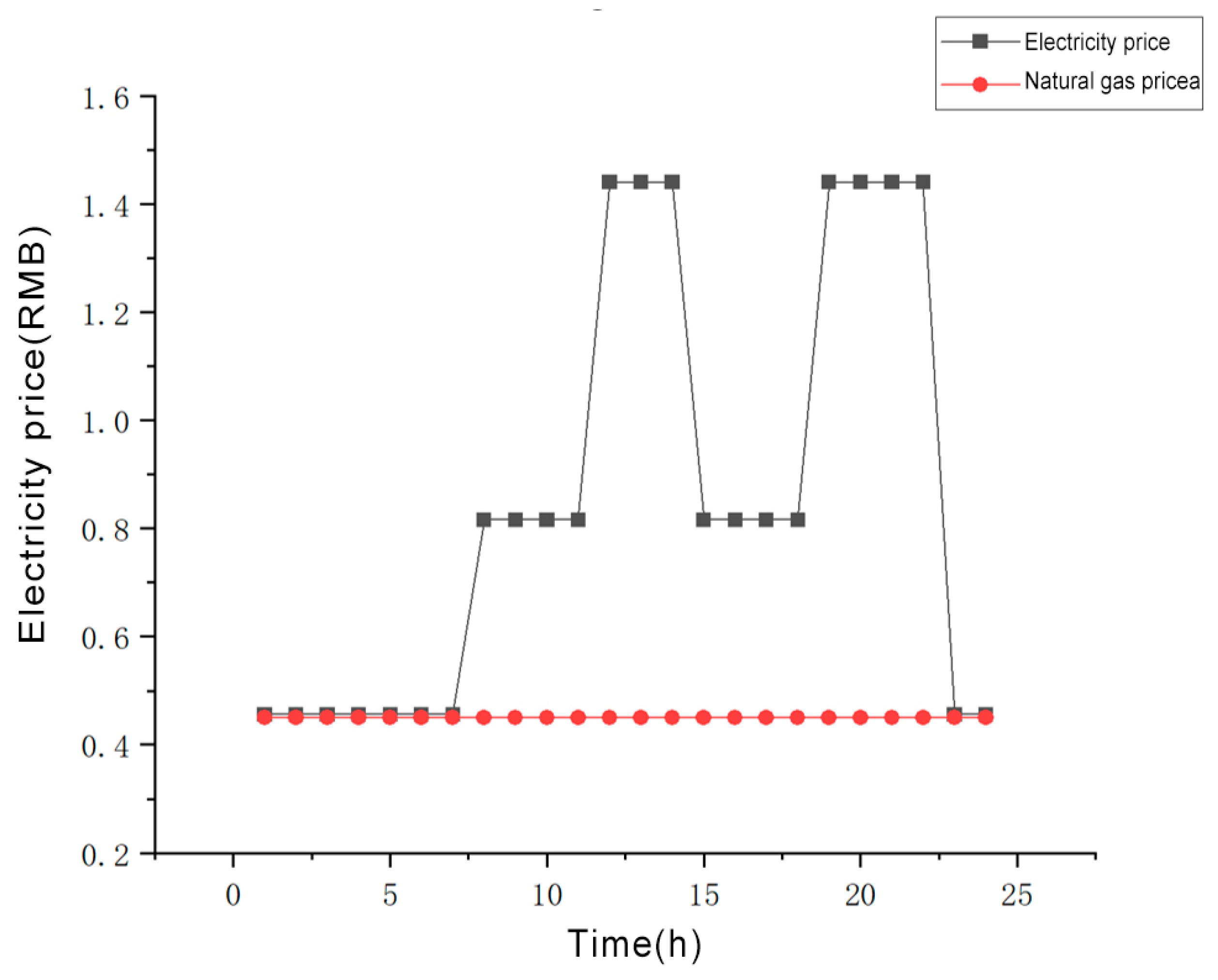

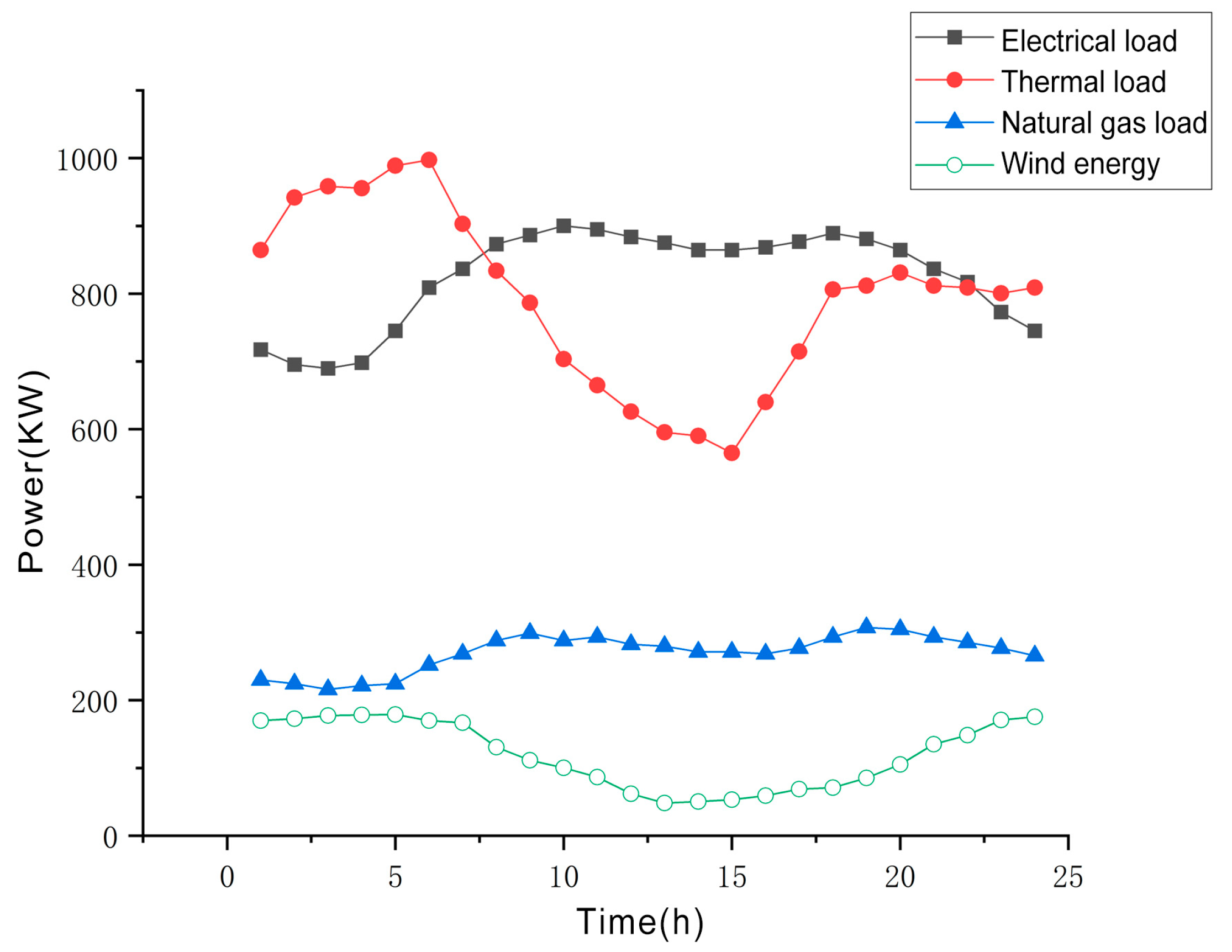
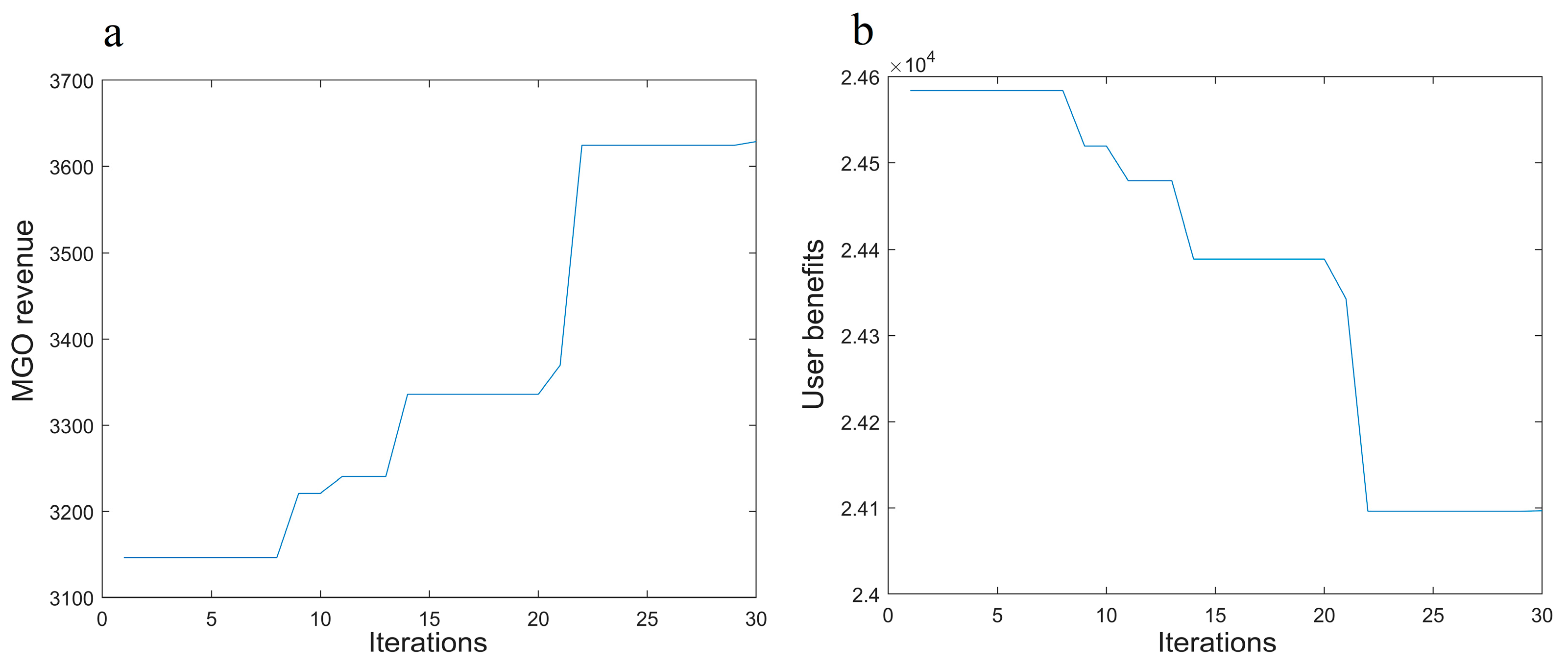
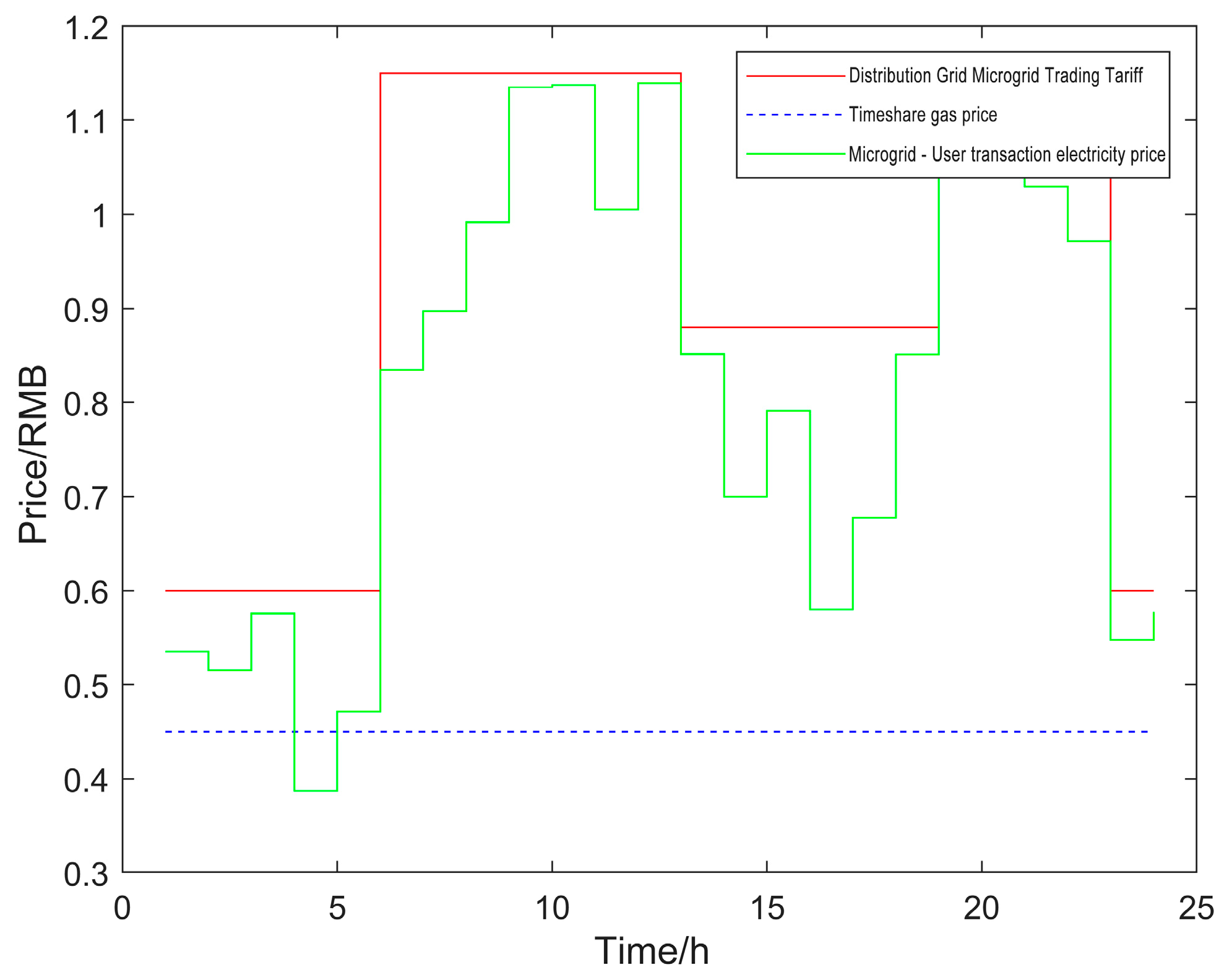


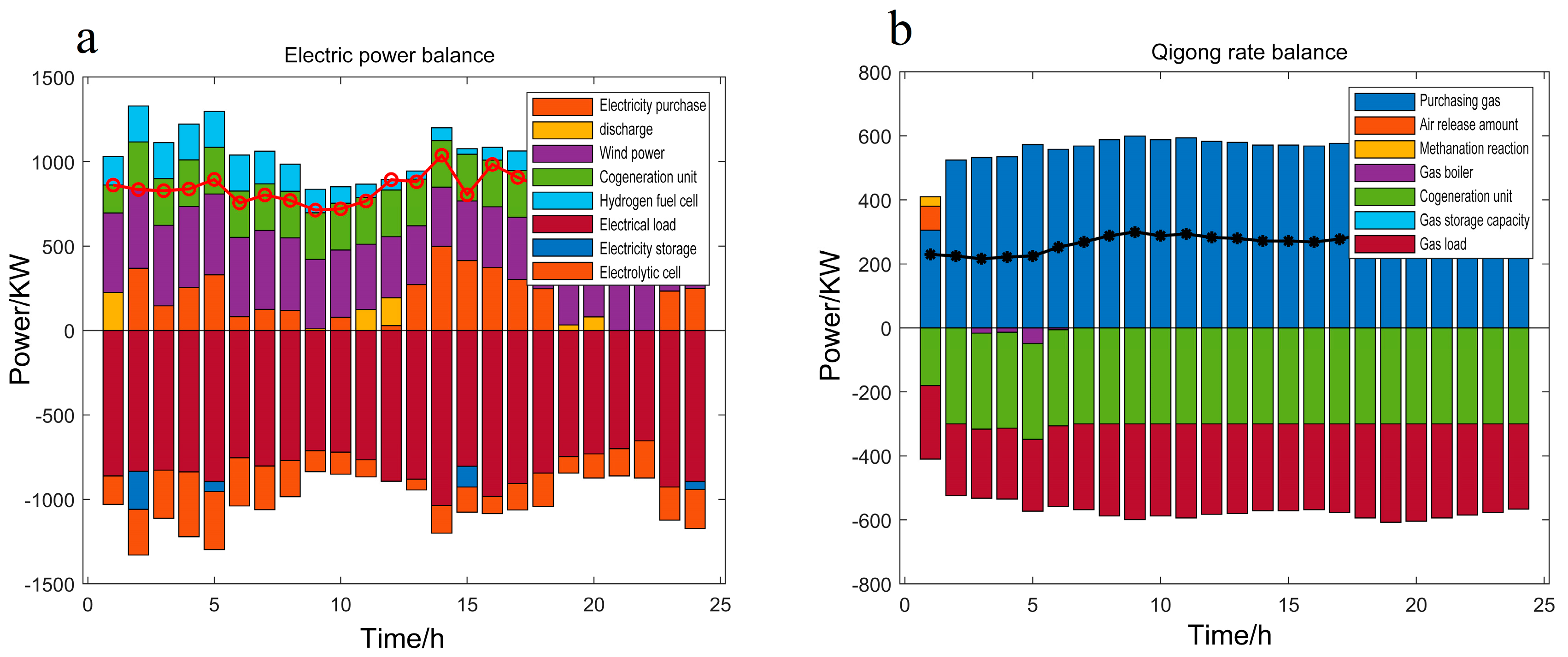
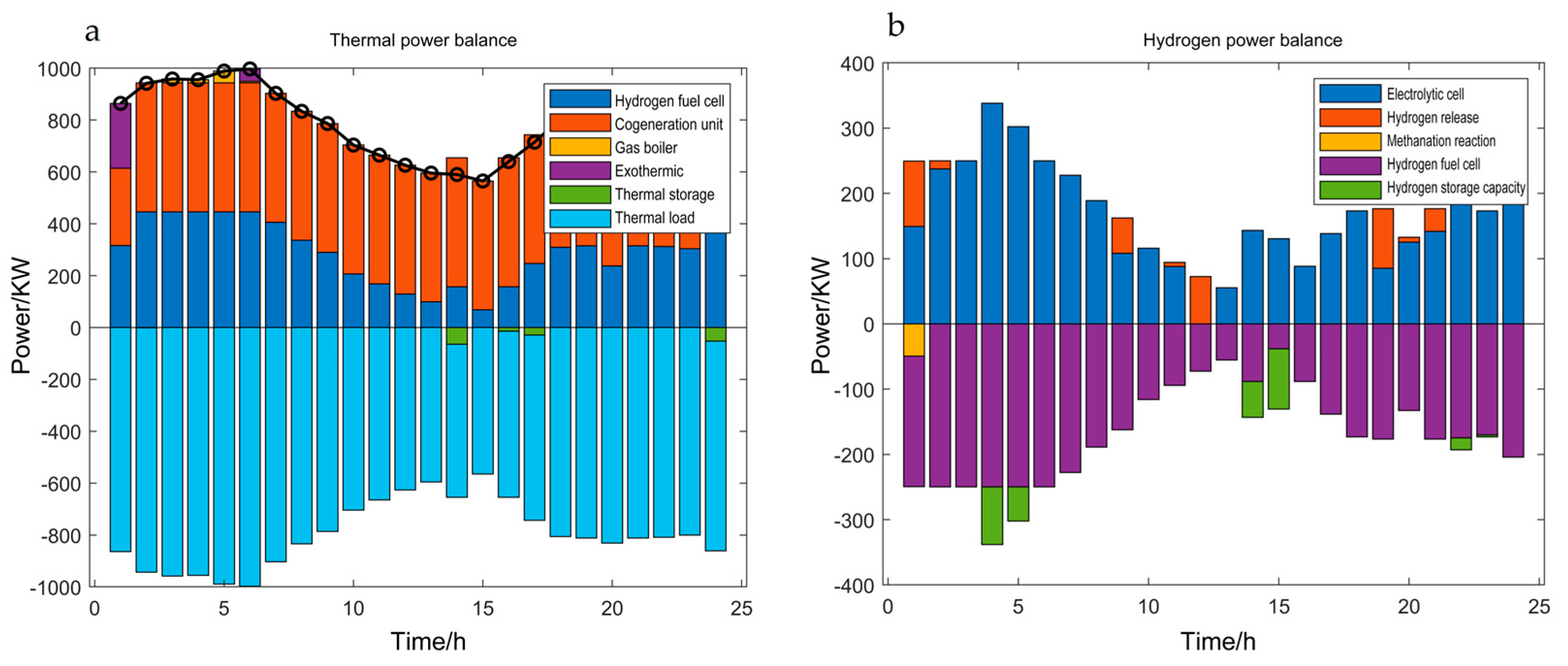


| Equipment | Value | Efficiency/Carbon Emissions Quota | Value |
|---|---|---|---|
| Carbon capture power plant contribution range/kwh | [0, 200] | 0.92 | |
| The range of thermal power union crew/kwh | [0, 300] | 0.88 | |
| Thermoelectrician Unit is a thermal power ratio | 1.8 | 0.6 | |
| The range of electrolytic tank equipment/kwh | [0, 500] | 0.85 | |
| Methane reaction force range/kwh | [0, 250] | 0.798 | |
| Hydrogen fuel cell contribution range/kwh | [0, 250] | 0.985 |
| Parameter Name | Value | Parameter Name | Value |
|---|---|---|---|
| 0.9 | −0.2 | ||
| 0.9 | 0.033 |
| Algorithm | Micro-Net Total Cost/RMB | Number of Iterations |
|---|---|---|
| MPGA | 11,667.04 | 31 |
| PSO | 12,306.73 | 74 |
| GA | 13,368.85 | 87 |
| Parameter | Consider Demand Response | Ignore Demand Response |
|---|---|---|
| Carbon emission/kg | 4857.90 | 4733.93 |
| Carbon trading cost/RMB | 2303.95 | 2261.96 |
| Power purchase cost/RMB | 3268.39 | 4046.99 |
| Gas purchase cost/RMB | 6094.70 | 6027.04 |
| Total cost/RMB | 11,667.04 | 12,335.99 |
Disclaimer/Publisher’s Note: The statements, opinions and data contained in all publications are solely those of the individual author(s) and contributor(s) and not of MDPI and/or the editor(s). MDPI and/or the editor(s) disclaim responsibility for any injury to people or property resulting from any ideas, methods, instructions or products referred to in the content. |
© 2023 by the authors. Licensee MDPI, Basel, Switzerland. This article is an open access article distributed under the terms and conditions of the Creative Commons Attribution (CC BY) license (https://creativecommons.org/licenses/by/4.0/).
Share and Cite
Li, B.; Li, Y.; Li, M.-T.; Guo, D.; Zhang, X.; Zhu, B.; Zhang, P.-R.; Wang, L.-D. Research on Optimal Scheduling of Multi-Energy Microgrid Based on Stackelberg Game. Processes 2023, 11, 2820. https://doi.org/10.3390/pr11102820
Li B, Li Y, Li M-T, Guo D, Zhang X, Zhu B, Zhang P-R, Wang L-D. Research on Optimal Scheduling of Multi-Energy Microgrid Based on Stackelberg Game. Processes. 2023; 11(10):2820. https://doi.org/10.3390/pr11102820
Chicago/Turabian StyleLi, Bo, Yang Li, Ming-Tong Li, Dan Guo, Xin Zhang, Bo Zhu, Pei-Ru Zhang, and Li-Di Wang. 2023. "Research on Optimal Scheduling of Multi-Energy Microgrid Based on Stackelberg Game" Processes 11, no. 10: 2820. https://doi.org/10.3390/pr11102820
APA StyleLi, B., Li, Y., Li, M.-T., Guo, D., Zhang, X., Zhu, B., Zhang, P.-R., & Wang, L.-D. (2023). Research on Optimal Scheduling of Multi-Energy Microgrid Based on Stackelberg Game. Processes, 11(10), 2820. https://doi.org/10.3390/pr11102820






